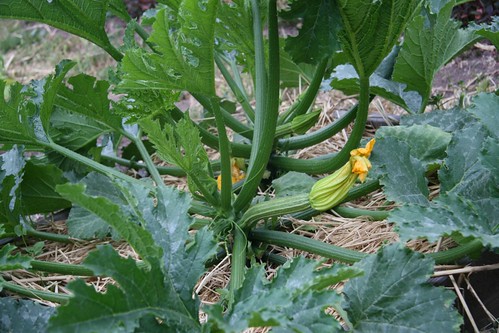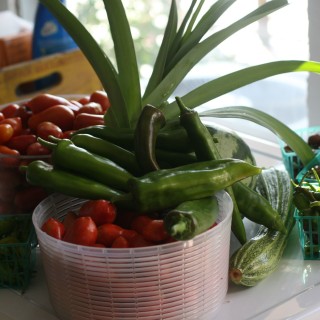Many of you asked at the book giveaway to learn more about succession planting and planning in the garden. Whew, that’s a tricky subject. I’d give succession planting an ‘advanced’ label if gardening tasks came with labels. To tell you the truth, we still stumble around with keeping the garden active at all times with a continuous harvest. While we always have at least a handful of edibles in the ground all year long, being in the spot we are in, we really could do much better at it. But it is a learning process and so each year we get a little bit better.
What is Succession Planting?
It seems easy, you just keep planting lettuce, radish, spinach, zucchini and whatever else you want to keep growing all season every few weeks or so, then you have a continual supply of vegetables. Replanting crops of one vegetable and replacing one vegetable with another all count as succession planting. This concept is especially relevant in long growing zones like ours. Our zucchinis are just coming into production but after a few weeks or so they’ll reach zucchini retirement, yet we’ll have plenty more zucchini growing weather left. So the thought is that you start a second crop of zucchini that will reach full production by the time our existing ones peter out. This year, we’ve got summer squash covered, because after our Portofino zucchinis are done, we have yellow crookneck squash starts waiting in the wings to take over. The tricky part? Where to put those crookneck squash.
We have three crops of carrots in the ground now each planted about a month apart. Carrots are relatively easy to plant successively because they are so skinny that they fit neatly between plants. This year we planted the first round between the peas, the second round alongside the tomatoes and the most recent round along the melons.

How to do Succession Planting in your own Yard?
I’d love to provide you with a neat and tidy chart of what to plant and when along with a garden layout of where you can plant your successive crops, but the truth is that you have to cater your succession planting to your specific yard. Our troubles with succession planting usually lie in where to put the second and third crops when our garden is already full. This year with the squash we’ll be able to pull out the russet potatoes in time to plant the crookneck squash. We somehow got lucky and as soon as the onions were ready to come out the peppers were ready to go in the ground in their spot. Once the garlic is ready to come out then we’ll have another empty bed to fill with maybe a fall crop of kale or chard. This sort of timing comes with practice and a healthy dose of intuition, which you will most certainly gain as you garden season after season.
Be prepared for trial and error when you try successive planting because you never know when you’ll get a freak heatwave that will torch your tender lettuce and spinach when you plant it too far out into the summer season. (as you can see, our lettuce and spinach days look to be over already:)
I have, however found some really great resources about succession planting to share with you.
- Square Foot Gardening does give really great step by step instructions on how to have successive harvests.
- This fantastic chart shows how many days until a vegetables maturity and how often you should sow seeds to keep your bounty flowing.
- Little House in the Suburbs has a more detailed plan on succession garden, complete with a spreadsheet to download.
- Simple Green Frugal also has a nice post on succession planting.
Are you able to successfully succession garden? Do you have any tricks to share?









I do a lot of succession cropping. My biggest issue this year is when will the garlic and onions be out of their beds. I need to time the fall brassicas to go in right afterward, but depending upon the timing it could be short season brassicas or longer season ones. Sigh. Next year I’ll have more of an idea.
I love that chart, it will be very helpful. I am trying to do succession crops of greens since they bolt so quickly in the summer. I’m not sure that I have the space to pull off larger items like squash. Carrots are another crop I’ll like to grow in this manner.
I would like to know the best practice to rotate crops to benefit each other. I find the best source for this information is an old time successful gardener in my neighborhood. Not only do you learn a bushel full from them; but they feel very worthwhile in their wisdom. Don’t forget to glean information regarding canning and storing your harvest.
I would enjoy reading anything you offer regarding crop rotation.
Wow, I’m so glad I found this site. So much helpful info, even for a beginner like me. Succession planting is definitely something I thought about with regards to space. I’m growing in containers since I’m a renter so it’s tricky but I’m going to try this fall. Should be easier since some of the things I’m growing don’t take forever to mature. I’m definitely bookmarking your site!
Thank you for making it easy to search about succession planting in Northern California. The tips are great as we’re growing a farm and with 11 garden beds we need all the help we can get. I’d like to piggy-back on Maybelline’s comments about crop rotation. I’ve read somewhere that if root veggies were planted the season before, that greens would take their place. In the case of tomatoes, corn and other nitrogen loving plants, are greens okay or should I stick with the legumes? Thanks for sharing the wisdom.